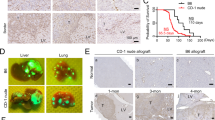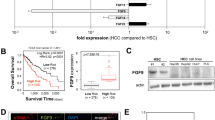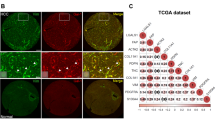Abstract
The tumor–stroma crosstalk is a dynamic process fundamental in tumor development. In hepatocellular carcinoma (HCC), the progression of malignant hepatocytes frequently depends on transforming growth factor (TGF)-β provided by stromal cells. TGF-β induces an epithelial to mesenchymal transition (EMT) of oncogenic Ras-transformed hepatocytes and an upregulation of platelet-derived growth factor (PDGF) signaling. To analyse the influence of the hepatic tumor–stroma crosstalk onto tumor growth and progression, we co-injected malignant hepatocytes and myofibroblasts (MFBs). For this, we either used in vitro-activated p19ARF MFBs or in vivo-activated MFBs derived from physiologically inflamed livers of Mdr2/p19ARF double-null mice. We show that co-transplantation of MFBs with Ras-transformed hepatocytes strongly enhances tumor growth. Genetic interference with the PDGF signaling decreases tumor cell growth and maintains plasma membrane-located E-cadherin and β-catenin at the tumor–host border, indicating a blockade of hepatocellular EMT. We further generated a collagen gel-based three dimensional HCC model in vitro to monitor the MFB-induced invasion of micro-organoid HCC spheroids. This invasion was diminished after inhibition of TGF-β or PDGF signaling. These data suggest that the TGF-β/PDGF axis is crucial during hepatic tumor–stroma crosstalk, regulating both tumor growth and cancer progression.
This is a preview of subscription content, access via your institution
Access options
Subscribe to this journal
Receive 50 print issues and online access
$259.00 per year
only $5.18 per issue
Buy this article
- Purchase on Springer Link
- Instant access to full article PDF
Prices may be subject to local taxes which are calculated during checkout







Similar content being viewed by others
References
Amann T, Bataille F, Spruss T, Muhlbauer M, Gabele E, Scholmerich J et al. (2009). Activated hepatic stellate cells promote tumorigenicity of hepatocellular carcinoma. Cancer Sci 100: 646–653.
Benckert C, Jonas S, Cramer T, Von Marschall Z, Schafer G, Peters M et al. (2003). Transforming growth factor beta 1 stimulates vascular endothelial growth factor gene transcription in human cholangiocellular carcinoma cells. Cancer Res 63: 1083–1092.
Bhowmick NA, Neilson EG, Moses HL . (2004). Stromal fibroblasts in cancer initiation and progression. Nature 432: 332–337.
Bissell MJ, Radisky D . (2001). Putting tumours in context. Nat Rev Cancer 1: 46–54.
Breuhahn K, Longerich T, Schirmacher P . (2006). Dysregulation of growth factor signaling in human hepatocellular carcinoma. Oncogene 25: 3787–3800.
Campbell JS, Hughes SD, Gilbertson DG, Palmer TE, Holdren MS, Haran AC et al. (2005). Platelet-derived growth factor C induces liver fibrosis, steatosis, and hepatocellular carcinoma. Proc Natl Acad Sci USA 102: 3389–3394.
Campbell JS, Johnson MM, Bauer RL, Hudkins KL, Gilbertson DG, Riehle KJ et al. (2007). Targeting stromal cells for the treatment of platelet-derived growth factor C-induced hepatocellular carcinogenesis. Differentiation 75: 843–852.
de Visser KE, Coussens LM . (2006). The inflammatory tumor microenvironment and its impact on cancer development. Contrib Microbiol 13: 118–137.
De Wever O, Demetter P, Mareel M, Bracke M . (2008). Stromal myofibroblasts are drivers of invasive cancer growth. Int J Cancer 123: 2229–2238.
Dooley S, Hamzavi J, Ciuclan L, Godoy P, Ilkavets I, Ehnert S et al. (2008). Hepatocyte-specific Smad7 expression attenuates TGF-beta-mediated fibrogenesis and protects against liver damage. Gastroenterology 135: 642–659.
Fickert P, Fuchsbichler A, Wagner M, Zollner G, Kaser A, Tilg H et al. (2004). Regurgitation of bile acids from leaky bile ducts causes sclerosing cholangitis in Mdr2 (Abcb4) knockout mice. Gastroenterology 127: 261–274.
Fischer AN, Fuchs E, Mikula M, Huber H, Beug H, Mikulits W . (2007). PDGF essentially links TGF-beta signaling to nuclear beta-catenin accumulation in hepatocellular carcinoma progression. Oncogene 26: 3395–3405.
Fischer AN, Herrera B, Mikula M, Proell V, Fuchs E, Gotzmann J et al. (2005). Integration of Ras subeffector signaling in TGF-beta mediated late stage hepatocarcinogenesis. Carcinogenesis 26: 931–942.
Forbes SJ, Russo FP, Rey V, Burra P, Rugge M, Wright NA et al. (2004). A significant proportion of myofibroblasts are of bone marrow origin in human liver fibrosis. Gastroenterology 126: 955–963.
Friedman SL . (2004). Mechanisms of disease: mechanisms of hepatic fibrosis and therapeutic implications. Nat Clin Pract Gastroenterol Hepatol 1: 98–105.
Gabbiani G . (2003). The myofibroblast in wound healing and fibrocontractive diseases. J Pathol 200: 500–503.
Geerts A . (2001). History, heterogeneity, developmental biology, and functions of quiescent hepatic stellate cells. Semin Liver Dis 21: 311–335.
Giannelli G, Bergamini C, Fransvea E, Sgarra C, Antonaci S . (2005). Laminin-5 with transforming growth factor-beta1 induces epithelial to mesenchymal transition in hepatocellular carcinoma. Gastroenterology 129: 1375–1383.
Gottardi CJ, Gumbiner BM . (2004). Distinct molecular forms of beta-catenin are targeted to adhesive or transcriptional complexes. J Cell Biol 167: 339–349.
Gotzmann J, Fischer AN, Zojer M, Mikula M, Proell V, Huber H et al. (2006). A crucial function of PDGF in TGF-beta-mediated cancer progression of hepatocytes. Oncogene 25: 3170–3185.
Gotzmann J, Huber H, Thallinger C, Wolschek M, Jansen B, Schulte-Hermann R et al. (2002). Hepatocytes convert to a fibroblastoid phenotype through the cooperation of TGF-beta1 and Ha-Ras: steps towards invasiveness. J Cell Sci 115: 1189–1202.
Gressner AM, Weiskirchen R, Breitkopf K, Dooley S . (2002). Roles of TGF-beta in hepatic fibrosis. Front Biosci 7: d793–d807.
Grunert S, Jechlinger M, Beug H . (2003). Diverse cellular and molecular mechanisms contribute to epithelial plasticity and metastasis. Nat Rev Mol Cell Biol 4: 657–665.
Herzig M, Savarese F, Novatchkova M, Semb H, Christofori G . (2007). Tumor progression induced by the loss of E-cadherin independent of beta-catenin/Tcf-mediated Wnt signaling. Oncogene 26: 2290–2298.
Ikegami T, Zhang Y, Matsuzaki Y . (2007). Liver fibrosis: possible involvement of EMT. Cells Tissues Organs 185: 213–221.
Iredale JP . (2007). Models of liver fibrosis: exploring the dynamic nature of inflammation and repair in a solid organ. J Clin Invest 117: 539–548.
Jechlinger M, Sommer A, Moriggl R, Seither P, Kraut N, Capodiecci P et al. (2006). Autocrine PDGFR signaling promotes mammary cancer metastasis. J Clin Invest 116: 1561–1570.
Kensler TW, Qian GS, Chen JG, Groopman JD . (2003). Translational strategies for cancer prevention in liver. Nat Rev Cancer 3: 321–329.
Kisseleva T, Uchinami H, Feirt N, Quintana-Bustamante O, Segovia JC, Schwabe RF et al. (2006). Bone marrow-derived fibrocytes participate in pathogenesis of liver fibrosis. J Hepatol 45: 429–438.
Knittel T, Kobold D, Saile B, Grundmann A, Neubauer K, Piscaglia F et al. (1999). Rat liver myofibroblasts and hepatic stellate cells: different cell populations of the fibroblast lineage with fibrogenic potential. Gastroenterology 117: 1205–1221.
Knittel T, Schuppan D, Meyer zum Buschenfelde KH, Ramadori G . (1992). Differential expression of collagen types I, III, and IV by fat-storing (Ito) cells in vitro. Gastroenterology 102: 1724–1735.
Lahsnig C, Mikula M, Petz M, Zulehner G, Schneller D, van Zijl F et al. (2009). ILEI requires oncogenic Ras for the epithelial to mesenchymal transition of hepatocytes and liver carcinoma progression. Oncogene 28: 638–650.
Lee HC, Kim M, Wands JR . (2006a). Wnt/Frizzled signaling in hepatocellular carcinoma. Front Biosci 11: 1901–1915.
Lee JS, Thorgeirsson SS . (2005). Genetic profiling of human hepatocellular carcinoma. Semin Liver Dis 25: 125–132.
Lee TK, Man K, Poon RT, Lo CM, Yuen AP, Ng IO et al. (2006b). Signal transducers and activators of transcription 5b activation enhances hepatocellular carcinoma aggressiveness through induction of epithelial-mesenchymal transition. Cancer Res 66: 9948–9956.
Magness ST, Bataller R, Yang L, Brenner DA . (2004). A dual reporter gene transgenic mouse demonstrates heterogeneity in hepatic fibrogenic cell populations. Hepatology 40: 1151–1159.
Marra F . (2002). Chemokines in liver inflammation and fibrosis. Front Biosci 7: d1899–d1914.
Mikula M, Proell V, Fischer AN, Mikulits W . (2006). Activated hepatic stellate cells induce tumor progression of neoplastic hepatocytes in a TGF-beta dependent fashion. J Cell Physiol 209: 560–567.
Morini S, Carotti S, Carpino G, Franchitto A, Corradini SG, Merli M et al. (2005). GFAP expression in the liver as an early marker of stellate cells activation. Ital J Anat Embryol 110: 193–207.
Moustakas A, Heldin CH . (2007). Signaling networks guiding epithelial-mesenchymal transitions during embryogenesis and cancer progression. Cancer Sci 98: 1512–1520.
Nitta T, Kim JS, Mohuczy D, Behrns KE . (2008). Murine cirrhosis induces hepatocyte epithelial mesenchymal transition and alterations in survival signaling pathways. Hepatology 48: 909–919.
Ostman A, Heldin CH . (2001). Involvement of platelet-derived growth factor in disease: development of specific antagonists. Adv Cancer Res 80: 1–38.
Pardali K, Moustakas A . (2007). Actions of TGF-beta as tumor suppressor and pro-metastatic factor in human cancer. Biochim Biophys Acta 1775: 21–62.
Parkin DM, Bray F, Ferlay J, Pisani P . (2005). Global cancer statistics, 2002. CA Cancer J Clin 55: 74–108.
Pinzani M, Milani S, Herbst H, DeFranco R, Grappone C, Gentilini A et al. (1996). Expression of platelet-derived growth factor and its receptors in normal human liver and during active hepatic fibrogenesis. Am J Pathol 148: 785–800.
Pollard JW . (2004). Tumour-educated macrophages promote tumour progression and metastasis. Nat Rev Cancer 4: 71–78.
Proell V, Mikula M, Fuchs E, Mikulits W . (2005). The plasticity of p19 ARF null hepatic stellate cells and the dynamics of activation. Biochim Biophys Acta 1744: 76–87.
Ramadori G, Veit T, Schwogler S, Dienes HP, Knittel T, Rieder H et al. (1990). Expression of the gene of the alpha-smooth muscle-actin isoform in rat liver and in rat fat-storing (ITO) cells. Virchows Arch B Cell Pathol Incl Mol Pathol 59: 349–357.
Roderfeld M, Weiskirchen R, Wagner S, Berres ML, Henkel C, Grotzinger J et al. (2006). Inhibition of hepatic fibrogenesis by matrix metalloproteinase-9 mutants in mice. FASEB J 20: 444–454.
Rossmanith W, Schulte-Hermann R . (2001). Biology of transforming growth factor beta in hepatocarcinogenesis. Microsc Res Tech 52: 430–436.
Russo FP, Alison MR, Bigger BW, Amofah E, Florou A, Amin F et al. (2006). The bone marrow functionally contributes to liver fibrosis. Gastroenterology 130: 1807–1821.
Sasaki T, Wiedemann H, Matzner M, Chu ML, Timpl R . (1996). Expression of fibulin-2 by fibroblasts and deposition with fibronectin into a fibrillar matrix. J Cell Sci 109 (Part 12): 2895–2904.
Sherman M . (2005). Hepatocellular carcinoma: epidemiology, risk factors, and screening. Semin Liver Dis 25: 143–154.
Sprenger H, Kaufmann A, Garn H, Lahme B, Gemsa D, Gressner AM . (1999). Differential expression of monocyte chemotactic protein-1 (MCP-1) in transforming rat hepatic stellate cells. J Hepatol 30: 88–94.
Stock P, Monga D, Tan X, Micsenyi A, Loizos N, Monga SP . (2007). Platelet-derived growth factor receptor-alpha: a novel therapeutic target in human hepatocellular cancer. Mol Cancer Ther 6: 1932–1941.
Thiery JP, Sleeman JP . (2006). Complex networks orchestrate epithelial–mesenchymal transitions. Nat Rev Mol Cell Biol 7: 131–142.
Tsuboi Y, Ichida T, Sugitani S, Genda T, Inayoshi J, Takamura M et al. (2004). Overexpression of extracellular signal-regulated protein kinase and its correlation with proliferation in human hepatocellular carcinoma. Liver Int 24: 432–436.
Witz IP . (2008). Yin-yang activities and vicious cycles in the tumor microenvironment. Cancer Res 68: 9–13.
Zeisberg M, Yang C, Martino M, Duncan MB, Rieder F, Tanjore H et al. (2007). Fibroblasts derive from hepatocytes in liver fibrosis via epithelial to mesenchymal transition. J Biol Chem 282: 23337–23347.
Acknowledgements
Mdr2 null mice were kindly provided by Dr Ilan Stein. We thank Dr Takako Sasaki for the fibulin-2 antibody. This work was supported by the Austrian Science Fund, FWF, grant numbers P19598-B13 (to WM) and SFB F28 (to RE, HB and WM), the ‘Hochschuljubiläumsstiftung der Stadt Wien’ (to WM), the Herzfelder Family Foundation (to WM), and the European Union, FP7 Health Research, project number HEALTH-F4-2008-202047 (to WM).
Author information
Authors and Affiliations
Corresponding author
Additional information
Supplementary Information accompanies the paper on the Oncogene website (http://www.nature.com/onc)
Supplementary information
Rights and permissions
About this article
Cite this article
van Zijl, F., Mair, M., Csiszar, A. et al. Hepatic tumor–stroma crosstalk guides epithelial to mesenchymal transition at the tumor edge. Oncogene 28, 4022–4033 (2009). https://doi.org/10.1038/onc.2009.253
Received:
Revised:
Accepted:
Published:
Issue Date:
DOI: https://doi.org/10.1038/onc.2009.253
Keywords
This article is cited by
-
Preoperative evaluation of microvascular invasion in hepatocellular carcinoma with a radiological feature-based nomogram: a bi-centre study
BMC Medical Imaging (2024)
-
Anti-tumor therapy of glycyrrhetinic acid targeted liposome co-delivery of doxorubicin and berberine for hepatocellular carcinoma
Drug Delivery and Translational Research (2024)
-
CAFs-derived SCUBE1 promotes malignancy and stemness through the Shh/Gli1 pathway in hepatocellular carcinoma
Journal of Translational Medicine (2022)
-
Prognostic analysis and risk stratification of lung adenocarcinoma undergoing EGFR-TKI therapy with time-serial CT-based radiomics signature
European Radiology (2022)
-
Mechanical transmission enables EMT cancer cells to drive epithelial cancer cell migration to guide tumor spheroid disaggregation
Science China Life Sciences (2022)



